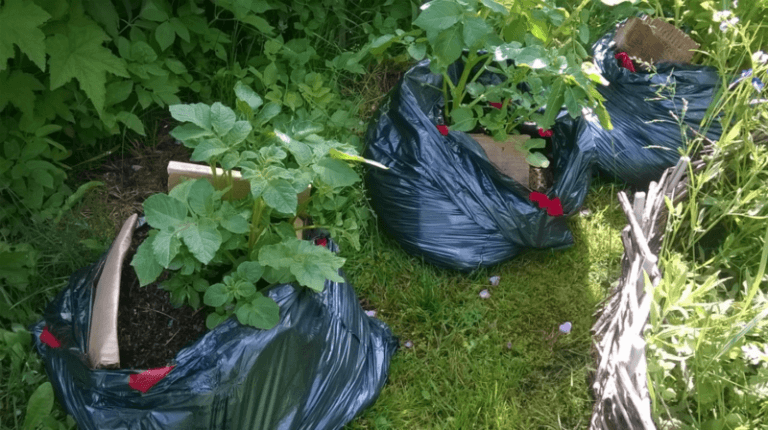Compost is prepared not only in the traditional way, storing raw materials in piles, but also in plastic bags. This technology has several advantages, so many gardeners liked it. Further it is considered in detail.

Benefits of making compost in bags
By making compost in a bag, you win the following:
- Ripening time is reduced from a year to 3 months.
- Human participation is minimized: for regular mixing, it is enough to turn and turn the bag over, watering is not required at all.
- The raw material is protected from rain and all kinds of insects, seeking to lay eggs in compost.
- Mobility: in extreme cold, bags can be transported to the barn.
- Weed control: in the area where the bags were laid out, due to lack of light, all unwanted vegetation dies.
The use of an airtight polymer shell allows the use of anaerobic microorganisms: for many of them, oxygen is deadly.
Disadvantages
- Costs for the purchase of bags, especially since relatively expensive products made of dense polyethylene are required.
- Loading all the raw materials at one time (in small areas it may not be enough).
- As you can see, there are much more “pluses” to this technology than “minuses”.
EXPERT OPINION
Many gardeners are skeptical of bag-based technology. This is actually the fastest way to get compost. And the beds can then be arranged directly in the container.
RAW MATERIAL
The selection of raw materials intended for composting has a number of requirements. You can put in a bag:
- Plant residues: ground weeds (possible with roots), tops of agricultural crops, fallen leaves, small twigs, sawdust, husks.
- Overdosed manure, bird droppings, land.
- Food waste, except meat, fish and fat (cause rot).
- Cardboard and other types of paper in its pure form (not coated and not laminated).
Humus and earth serve as sources of germs. Without them, loading will turn into a silo. Land on the roots of torn weeds will be enough. It is also important to take equal amounts of nitrogen raw materials (greens, humus and bird droppings) and carbon (branches, fruits, etc. other than green).
Cannot be loaded into a bag
- plastics, synthetic fabrics, other inorganic debris;
- partially infected plants;
- potato and tomato leaves, citrus peel (contain bactericidal components);
- Especially tenacious weeds: bark and bindweed, etc.
STEP-BY-STEP INSTRUCTION
Follow the following procedure:
- Buy bags with a volume of 250-300 l (in a small bag, the raw material dries and freezes). The density of polyethylene is high. Check by stretching: good material does not stretch. The thin bag will burst. Color should be chosen black. Such material absorbs more solar heat, and bacteria act more actively in a warm environment. Transparency is zero. This will prevent the death of microbes from UV radiation.
- Grind the raw materials. This will increase the contact surface with microflora, and accordingly the decomposition rate.
- Load raw materials in a bag with alternating layers: the green mass is replaced by brown. The bookmark is well sealed.
- When using a biological product (specially grown microbes), they watered each layer. If the raw material is dry (not enough greens and other juicy components) and the biological product is not used, each layer is moderately watered with water.
- After collecting the neck of the filled bag, bandage it with tape.
- If anaerobic bacteria are used, for example, Doctor Robik, the neck is additionally tied with twine, having previously squeezed out as much air as possible from the bag.
It remains to lay out the bags on the site, several hours a day illuminated by the sun (overheating is harmful), and before severe frosts - bring it into the room.
As practice has shown, in bags with a capacity of 250 l, bacteria tolerate frosts at -20 ...– 25 degrees Celsius.